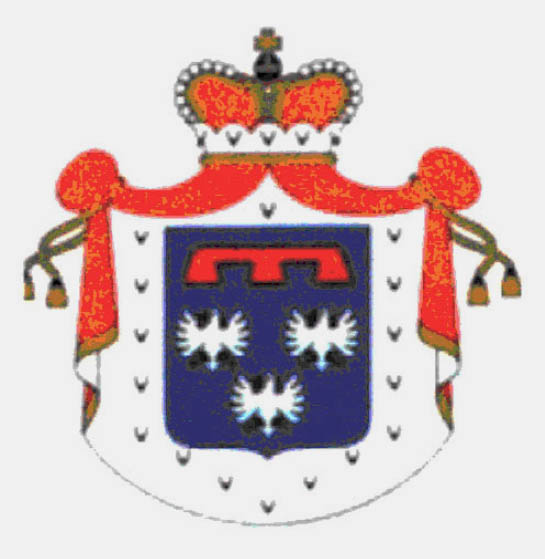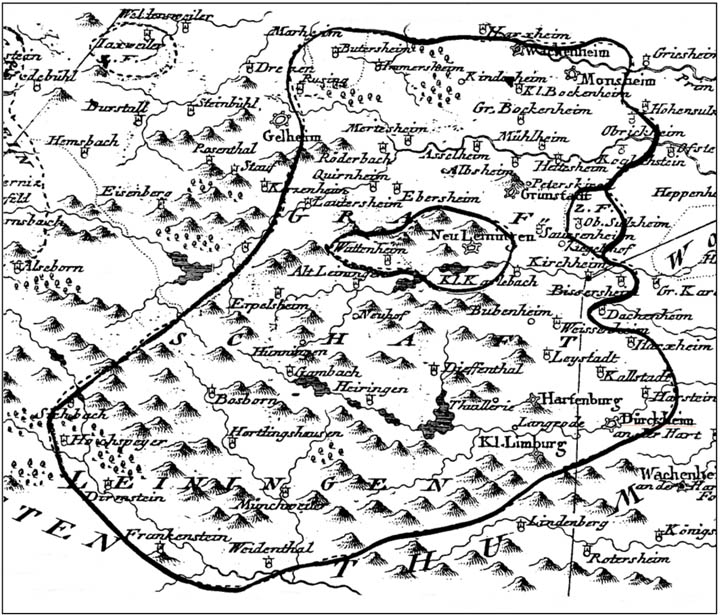Houses of Leiningen

The tradition that Friedrich Carl Christlieb had somehow been associated with a reigning family in Germany was one that was passed down in the Pennsylvania branch of the family. The intrigue generated by this tradition was the principle impetus for Benjamin Franklin Christlieb’s writing The Christlieb Family, which he published privately in 1895.
Friedrich Carl was apparently proud of his connection with the ruling class, but he was careful not to pass on specific details of the connection, as to do so would have revealed that his baptism included his conversion from Judaism. The actual connection was finally revealed in 1977, when the “Amorbach Letter” was discovered among the holdings of the Leiningen Archive in Amorbach, Bavaria. The letter, along with his baptismal/conversion and marriage entries at Dürkheim, revealed that his conversion was endorsed by two of the Counts of Leiningen. The following was gleaned from these documents:
Christian Carl Reinhard, Count of Leiningen-Dagsburg-Heidesheim, served as God-sponsor for Simon aus Frankenstein when he converted from Judaism to Christianity in 1742. Indeed, his entire household was present on this holy occasion. Also serving as God-sponsor was Friedrich Magnus, Count of Leiningen-Dagsburg-Hartenburg. Nine years later, Friedrich Magnus and his family were present at the baptism of Friedrich Carl and Anna Catharina’s younger son, Friedrich Carl II.
Inasmuch as an association between Friedrich Carl Christlieb and the Houses of Leiningen has been proved, the following information should be of interest to his descendants:
The Counts of Leiningen enjoyed status, respect, and parity with the rulers of the myriad principalities that existed in what would eventually become Germany. In time, some Counts were elevated to Princes of the Holy Roman Empire. Enjoying the status as Electors, they had a voice in the selection of the Emperor of the Holy Roman Empire.
The history of the various Houses of Leiningen is extremely complex. Within the territory of the German Rhineland, the Counts of Leiningen had ruled over various areas for generations. The Principality of Leiningen originally lay on the left side of the Rhine from Dürkheim to Lorraine in Alsace.
In the high Middle Ages, the Counts of Leiningen were the second most powerful rulers after the Palatine Counts in South Rhineland Palatinate. Although there are suggestions that the rulers of Leiningen might be traced back to the 8th century, the earliest Count of Leiningen appears to have been Emich I, who died in 1117. Emich’s family line became extinct in the male line when Count Friedrich, a Minnesinger, died ca. 1220.

Count Emich I was designated as the Emperor Henry IV’s personal bodyguard when he and his countrymen participated in the first crusade in 1096. Those participating in the crusade were organized into separate divisions, each under a distinguished feudal leader. Shown here is a highly stylized representation of the Emich I’s bow, which has been adopted as an identifying symbol for the City of Bad Dürkheim. Not to Emich I’s credit is the fact that he staged the first bloody persecution of Jews in the west. During his tenure he was twice excommunicated.
Count Emich’s sister, Liutgarde, married Simon, Count of Saarbrücken, and Friedrich, one of their sons, inherited the lands of the Counts of Leiningen. With his inheritance, Friedrich assumed their arms and their name. By 1317, because of its increased size, the family was divided into two branches; the elder of these whose head was a Landgrave, died out in 1467. On this event its land fell to a female, the last Landgrave’s sister, Margaret, wife of Reinhardt, Lord of Westerburg, and their descendants were known as the family of Leiningen-Westerburg. Later this family was divided into two branches, those of Alt-Leiningen-Westerburg and Neu-Leiningen-Westerburg, both of which are represented today.
Meanwhile the younger branch of the Leiningens, known as the family of Leiningen-Dagsburg, flourished. In 1560, the lines of Leiningen-Dagsburg were divided in two: The lines of Leiningen-Dagsburg-Hartenburg founded by Count Johann Philip and Leiningen-Dagsburg-Heidesheim or Falkenburg founded by Count Emicho.
The line of the family known as Leiningen-Dagsburg-Heidesheim originated in 1608 in Heidesheim near Grünstadt, where they built a castle. Eventually, the family was divided into three branches. The eldest two of these lines became extinct. Count Christian Carl of Leiningen-Dagsburg-Heidesheim [Heddesheim] (1695- 1766) was one of Friedrich Carl Christlieb’s God-sponsors when he was baptized a Christian in 1742.

An old map of the principality of Leiningin. Its capital city, Dürkheim, is shown near the lower right. To the left are the cloister Limburg and Hardenburg Castle. The region known as Neu Leiningen is encircled in the center.
The line of Leiningen-Dachsburg-Hardenburg built one of the largest and most powerful castles in the Palatinate. The origins of Hardenburg Castle can be traced back to the 13th century, when the Counts of Leiningen illegally built the castle on lands belonging to the Abbey of Limburg. Quarrels about this lasted until 1249, until the monastery granted the disputed land to the Counts of Leiningen in return for a number of concessions elsewhere. Friedrich Magnus of this line (1703-1756) also served as Godfather of Friedrich Carl Christlieb. In 1779, Friedrich Magnus’ son, Karl Friedrich, was elevated to the rank of a Prince of the Empire. His son, Count Emich Carl (1763-1814), was the first husband of Queen Victoria’s mother, Princess Victoria of Saxe-Colburg-Saalfeld. Other familial relationships followed in later generations of this particular Leiningen family. As a result, their many descendants occupy places high up in the British line of succession.
In 1779, the head of Leiningen-Dagsburg-Hardenburg line was elevated to the rank of a Prince of the Empire. Friedrich Magnus of Leiningen-Hardenburg (1703-1756) was the Godfather of Friedrich Carl Christlieb’s second son, Friedrich Carl II.
Count Christian Carl Reinhard of Leiningen-Dagsburg-Heidesheim and Count Friedrich Magnus of Leiningen-Dagsburg-Hartenburg, both of whom served as God-sponsors at the baptism of Friedrich Carl Christlieb, shared common ancestry. Being fourth cousins, these two Leiningen Counts were related through their third great-grandparents, Count Emich of Leiningen (1498-1541) and Catharina von Nassau-Saarbrücken (1517-1533).
Contemporaneous with Christian Carl Reinhard and Friedrich Magnus was another Count of Leiningen; Emich Ludwig, Count of Leiningen-Guntersblum, whose reign extended from 1719-1766. Like Christian Carl and Friedrich Magnus his realm was also in the Lower Palatinate. These Counts were subjects of Prince Carl Philipp III. (The distance from Guntersblum to Dürkheim is approximately 24 miles. The distance between Guntersblum and Grünstadt is 18 miles.)
The French Revolutionary wars drastically changed the political map of Central Europe. In 1793-1794 the French armies occupied lands of the empire on the left band of the Rhine and many reigning houses lost their immediate territories. One of the first of these to go was Leiningen-Dachsburg-Heidesheim, when the French overran the territory and destroyed the Castle at Heidesheim in 1793.
A few months later on January 1, 1794, some twenty-nine years after Friedrich Carl Christlieb and his family departed the region; the French burned the city of Dürkheim, as well as the Leiningen-Dagsburg-Hardenburg palace. Three months later they burned Hardenburg Castle, former residence of the Counts of that line.
The Counts of Leiningen-Hartenburg and Leiningen-Heidesheim, along with twenty-three other Dukes, Counts, and Princes, lost their positions as territorial rulers as a result of the French invasion. Inasmuch as Count Christian Carl Reinhard had left no male heirs, the Leiningen-Dagsburg-Heidesheim line came to an end. In 1803, Count Karl Friedrich of Leiningen-Hartenburg was rewarded with a token principality in Bavaria. The former Cloister at Amorbach with its magnificent rococo chapel became the palace for the Leiningen court.
The region that included Dürkheim became a part of the Kingdom of Bavaria in 1820, where it remained beyond the time when Benjamin Franklin Christlieb made his inquiries in the latter part of the 19th century. This explains why descendants erroneously came to believe that Friedrich Carl Christlieb hailed from Bavaria.
Prior to the destruction of the Leiningen palace at Dürkheim and the nearby Hardenburg Castle, archival materials were packed in wine casks and floated across the Rhine to safety. After the Leiningen Court was safely established at Amorbach, the materials became safely housed in what was to become the Leiningen Archives.
Not all of the Leiningen papers made it to safety. Materials confiscated by the French were sent to Paris, where they remain to this day. Fortunately, the Amorbach Letter, which reveals the origin of the Christlieb-Chrislip-Crislip Family, was not among them. The letter remains a part of the holdings of the Leiningen Archive at Amorbach.
With the unification of Germany in the 19th century under Bismarck, the highly regarded Leiningen line was no longer a viable entity. Although they no longer had power, certain of the Leiningens continued on in name only.
SOURCES:
Brinckmeier, Eduard. Genealogische Geschichte des Hauses Leiningen (Burnswick, 1890-1891). Encyclopaedia Britannica, 1911. Feldmann, Georg et al. Bad Dürkheim Chronic einer Salierstadt: Pfälische Verlangsanstalt, Landau, Deutschland, 1978. Hayes, J.H. et al. History of Europe: The Macmillan Company, New York, 1949. Klimm, Franz. Limburg, Cloister Seebach and Hardenburg: Verlag Jaeger – Speyer am Rhein, 1954.




